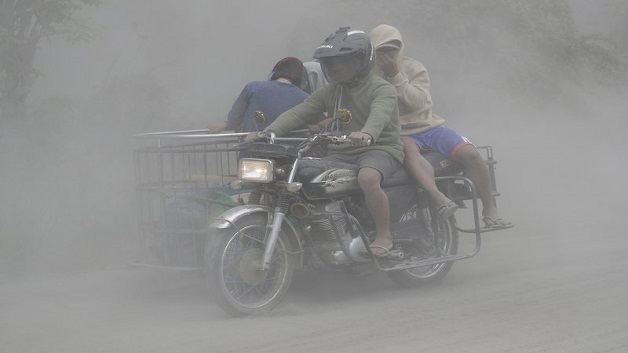TAGAYTAY, Philippines (AP) — Red-hot lava spewed from a volcano near the Philippine capital of Manila on Monday as tens of thousands of people fled through heavy ash and frightening tremors, and authorities made plans to evacuate hundreds of thousands more for fear of a bigger eruption.
Clouds of ash from the Taal volcano reached Manila, 65 kilometres (40 miles) to the north, on Sunday, forcing the shutdown of the country’s main airport, with more than 500 flights cancelled. The airport partially reopened Monday after the ash fall eased.
There were no immediate reports of any deaths or major damage directly blamed on the eruption. A truck, however, skidded out of control on an ash-blanketed road, killing the driver and injuring three companions in Laguna province in an accident police said may have been linked to slippery conditions.
The government’s disaster-response agency and other officials reported more than 30,000 villagers fled their homes in the hard-hit province of Batangas and nearby Cavite province. Officials expected the number to swell.
Some residents could not immediately flee their ash-blanketed villages because of a lack of transportation and poor visibility. Others refused to leave their homes and farms.
After a clean-up and a shift of ash-laden winds away from Manila, officials partially reopened the main airport and allowed planes to take off. President Rodrigo Duterte’s aircraft was able to land in Manila on Monday from his hometown of Davao, his spokesman said, adding he saw the extent of the disaster from the plane.
Taal suddenly rumbled back to life on Sunday, blasting steam, ash and pebbles up to 10 to 15 kilometres (6 to 9 miles) into the sky, according to the Philippine Institute of Volcanology and Seismology.
On Monday, the ash and steam column reached a height of 2 kilometres (about a mile), with lava fountains spurting less than half of that height before falling into the lake waters surrounding the main crater. Lava also spurted from another vent north of the main crater, said Renato Solidum, who heads the institute.
Frequent tremors and a build-up of pressure of the 1,020-foot (311-metre) volcano, one of the world’s smallest, however, indicated a major and much more dangerous eruption could still happen, he said.
The government volcano-monitoring agency raised the danger level around Taal three notches on Sunday to Level 4, indicating a hazardous eruption within hours to days was possible. Level 5, the highest, means such an eruption is underway.
The volcano’s last disastrous eruption happened in 1965, when more than 200 people were killed.









